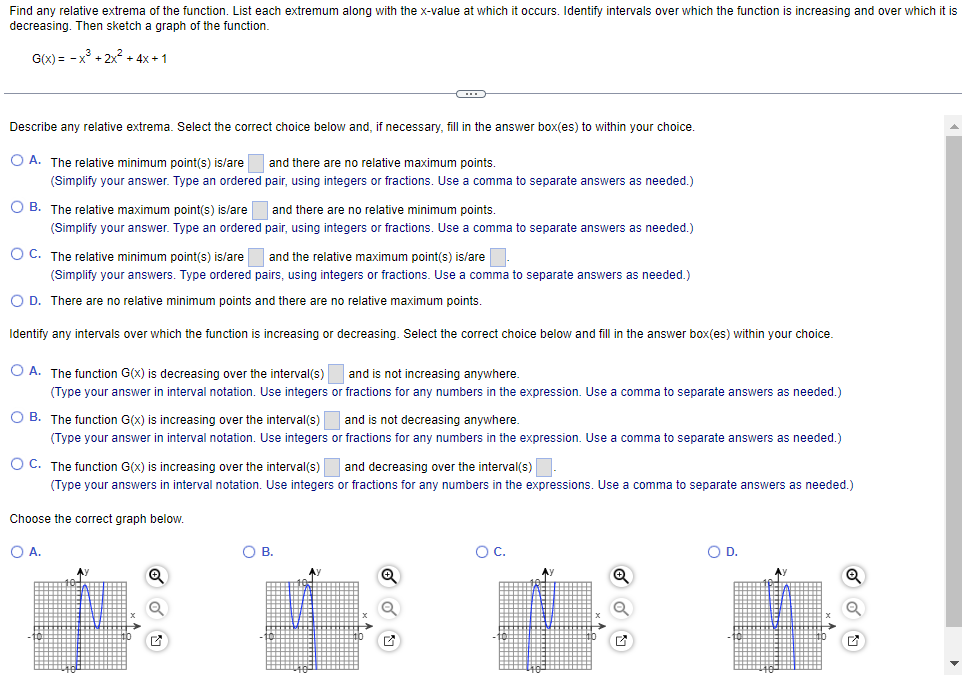w you found the relative extreme values using Calculus based methods a. Show how you found the critical point(s). b. Clearly identify how you determined whether a critical point was a relative maximum, relative minimum, or neither by giving evidence c. Make sure to show the c
w you found the relative extreme values using Calculus based methods a. Show how you found the critical point(s). b. Clearly identify how you determined whether a critical point was a relative maximum, relative minimum, or neither by giving evidence c. Make sure to show the c
Glencoe Algebra 1, Student Edition, 9780079039897, 0079039898, 2018
18th Edition
ISBN:9780079039897
Author:Carter
Publisher:Carter
Chapter9: Quadratic Functions And Equations
Section9.2: Transformations Of Quadratic Functions
Problem 48PFA
Related questions
Question
Show how you found the relative extreme values using Calculus based methods
a. Show how you found the critical point(s).
b. Clearly identify how you determined whether a critical point was a
relative minimum, or neither by giving evidence
c. Make sure to show the check values you used to test whether the function is increasing or
decreasing over each of the indicated subintervals.

Transcribed Image Text:Find any relative extrema of the function. List each extremum along with the x-value at which it occurs. Identify intervals over which the function is increasing and over which it is
decreasing. Then sketch a graph of the function.
G(x)= x² + 2x² + 4x+1
Describe any relative extrema. Select the correct choice below and, if necessary, fill in the answer box(es) to within your choice.
O A. The relative minimum point(s) is/are
(Simplify your answer. Type an ordered
OB. The relative maximum point(s) is/are
(Simplify your answer. Type an ordered
OC. The relative minimum point(s) is/are
and the relative maximum point(s) is/are
(Simplify your answers. Type ordered pairs, using integers or fractions. Use a comma to separate answers as needed.)
O D. There are no relative minimum points and there are no relative maximum points.
Identify any intervals over which the function is increasing or decreasing. Select the correct choice below and fill in the answer box(es) within your choice.
✪
and there are no relative maximum points.
pair, using integers or fractions. Use a comma to separate answers as needed.)
OA. The function G(X) is decreasing over the interval(s)
and is not increasing anywhere.
(Type your answer in interval notation. Use integers or fractions for any numbers in the expression. Use a comma to separate answers as needed.)
OB. The function G(X)
increasing over the interval(s) and is not decreasing anywhere.
(Type your answer in interval notation. Use integers or fractions for any numbers in the expression. Use a comma to separate answers as needed.)
OC. The function G(x) increasing over the interval(s) and decreasing over the interval(s)
(Type your answers in interval notation. Use integers or fractions for any numbers in the expressions. Use a comma to separate answers as needed.)
Choose the correct graph below.
O A.
Q
and there are no relative minimum points.
pair, using integers or fractions. Use a comma to separate answers as needed.)
✔
O B.
O C.
O D.
Q
Expert Solution
This question has been solved!
Explore an expertly crafted, step-by-step solution for a thorough understanding of key concepts.
Step by step
Solved in 5 steps with 14 images

Recommended textbooks for you

Glencoe Algebra 1, Student Edition, 9780079039897…
Algebra
ISBN:
9780079039897
Author:
Carter
Publisher:
McGraw Hill

College Algebra (MindTap Course List)
Algebra
ISBN:
9781305652231
Author:
R. David Gustafson, Jeff Hughes
Publisher:
Cengage Learning

Elementary Linear Algebra (MindTap Course List)
Algebra
ISBN:
9781305658004
Author:
Ron Larson
Publisher:
Cengage Learning

Glencoe Algebra 1, Student Edition, 9780079039897…
Algebra
ISBN:
9780079039897
Author:
Carter
Publisher:
McGraw Hill

College Algebra (MindTap Course List)
Algebra
ISBN:
9781305652231
Author:
R. David Gustafson, Jeff Hughes
Publisher:
Cengage Learning

Elementary Linear Algebra (MindTap Course List)
Algebra
ISBN:
9781305658004
Author:
Ron Larson
Publisher:
Cengage Learning

Trigonometry (MindTap Course List)
Trigonometry
ISBN:
9781337278461
Author:
Ron Larson
Publisher:
Cengage Learning


Algebra & Trigonometry with Analytic Geometry
Algebra
ISBN:
9781133382119
Author:
Swokowski
Publisher:
Cengage